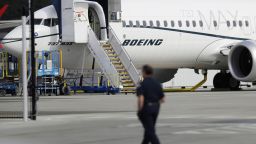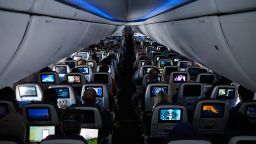Boeing has achieved the unthinkable this week: It managed to fall even deeper into crisis.
Adding to an already miserable start to 2024, Boeing stood accused Tuesday of routinely ignoring a whistleblower’s complaints about the allegedly critically flawed manufacturing process for its 787 Dreamliner planes. The whistleblower claimed Boeing retaliated against him and put him on the 777 unit as punishment. That’s when, he says, he found even more production problems.
Boeing strongly denies the claims and says it is confident in the safety of its aircraft. Still, the US Federal Aviation Administration (FAA) said it would investigate — adding to a growing list of federal probes into the beleaguered company, including a criminal investigation. And next week, a Senate subcommittee will hear testimony about the whistleblower’s case and will presumably air more of Boeing’s dirty laundry in public.
More allegations of lax safety standards are the last thing the company — and the flying public — need right now. The whistleblower complaint is doing further damage to Boeing’s already battered public image: a company with a broken safety record, led by highly paid executives who are careless about quality standards.
Yet the bad news for Boeing apparently knows no end.
The whistleblower’s accusations
The whistleblower, Sam Salehpour, a Boeing engineer, alleged that Boeing took shortcuts when manufacturing its 777 and 787 Dreamliner jets — skipping crucial safety steps, which could lead to catastrophic failure of the airplanes as they age. The shortcuts could dramatically reduce the airplanes’ expected lifespan of up to 50 years in service. The New York Times was first to report the whistleblower’s claims.
His formal complaint to the FAA, filed in January and made public Tuesday, was not entirely new — the FAA had already investigated Boeing over 787 production concerns and halted 787 deliveries. But Salehpour’s complaint shed new light on how crews assembling the 787 Dreamliner apparently failed to properly fill tiny gaps when joining separately manufactured parts of the fuselage for 1,000 planes. That could add stress on the planes’ joints, something that can be hard to identify in inspections, Salehpour said.
He alleged Boeing knew about the process errors and, what’s more, encouraged them in order to reduce 787 assembly bottlenecks.
Boeing has said the 787 is safe to fly and, before halting deliveries of the model, the FAA rigorously scrutinized Boeing’s manufacturing processes that Salehpour questioned. It ultimately approved the planes for shipments to airlines in March 2023 after becoming satisfied that Boeing had fixed the problem.
“These claims about the structural integrity of the 787 are inaccurate and do not represent the comprehensive work Boeing has done to ensure the quality and long-term safety of the aircraft,” the company said in a statement Tuesday.
Salehpour said that in his new role at the 777 unit he discovered subpar work, with crews misaligning body pieces while Boeing pressured engineers to approve work they had not yet inspected.
“We are fully confident in the safety and durability of the 777 family,” Boeing said in a statement Wednesday. “These claims are inaccurate.”
How Boeing got here
The latest accusations are pouring gasoline on a dumpster fire.
Critics argue the company’s once sterling safety reputation was tarnished in its ill-advised 1997 merger with McDonnell Douglas, and it has been all downhill from there, culminating in two fatal crashes of the 737 Max in 2018 and 2019. Boeing acknowledged it was liable for those crashes — and that they were caused by a design flaw it has since fixed after a nearly two-year grounding.
The recent nonstop streak of bad news began during the last week of 2023, when an airline discovered a potential problem with a key part on two 737 Max aircraft.
Then, during the first weekend of 2024, part of an Alaska Airlines 737 Max blew off the side of the plane just after take-off, and Boeing has been in crisis mode ever since. A preliminary investigation by the National Transportation Safety Board revealed that Boeing probably did not put the bolts in the so-called door plug that are designed to prevent the part from blowing off the plane. Boeing hasn’t acknowledged the specific accusations in the federal report, although CEO Dave Calhoun admitted the company made a mistake and said in response to the probe that Boeing is ultimately responsible.
That incident resulted in a temporary nationwide grounding of certain 737 Max jets, followed by congressional hearings, production and delivery delays, multiple federal investigations — including the criminal probe — and a fall of about 30% in Boeing’s stock this year, which shaved nearly $50 billion off the company’s market valuation.
The bad news didn’t stop there. In February, pilots on a United Airlines 737 Max reported that the flight controls jammed as the plane landed in Newark, New Jersey. A month ago, the FAA flagged safety issues with the de-icing equipment on 737 Max and 787 Dreamliner models that could cause engines to lose thrust. The FAA is allowing the planes to continue flying and Boeing said the problem does not pose an immediate safety risk.
But, after reviewing Boeing’s production workflow and standards, FAA Administrator Mike Whitaker said last month that the regulator found issues with “really important” aspects of Boeing’s manufacturing and assembly line and gave the company until late May to produce a plan to fix is production problems.
Boeing said it is working on several of the issues Whitaker identified.
What’s next for Boeing
The fallout for Boeing has reached the top ranks of its leadership. The company has let several executives go, including the overseer of its commercial jets and a longtime executive in charge of the 737 Max unit. CEO Dave Calhoun also said he would step down before the end of the year — after he was paid $32.8 million last year and as he is set to take home $45 million for his retirement.
Boeing’s latest problems will cost it dearly: Airlines effectively stopped ordering planes from Boeing in January, and the only 737 Max planes they ordered last month were for the version that isn’t allowed to fly yet — specifically, the larger Max 10 — because of the de-icing issue. The company could also be subject to hefty fines and onerous lawsuits. Boeing has already paid Alaska Airlines more than $150 million in compensation for the temporary grounding of its planes following the door plug blowout.
The company hasn’t turned a profit in years, and the Alaska Airlines incident won’t help Boeing make money this year either.
Boeing faces no existential threat, though. The company has just one major competitor in the production of commercial aircraft globally — Airbus. Airlines can’t easily switch between airplane manufacturers, making the company immune to typical market forces like passengers choosing a different manufacturer. Although there’s some evidence that angry or nervous flyers prefer Airbus flights, opting for that can be impractical or impossible depending on where they want to travel.
Still, Boeing’s shareholders, regulators and customers are growing more irate by the day, and the company is ultimately beholden to them. Boeing’s already bruised reputation means regaining airlines’ trust could prove difficult — let alone the confidence of flabbergasted regulators. The drip, drip, drip of bad news makes a turnaround even harder.
With new leadership on its way, Boeing’s future top brass have their work cut out for them. And the world’s eyes will be on them.
CNN’s Gregory Wallace and Gabe Cohen contributed to this report.










